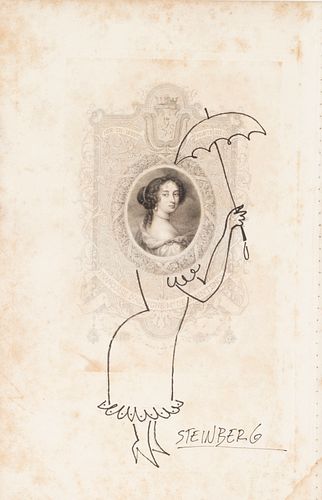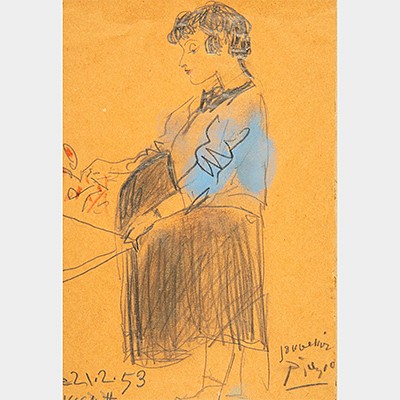SAÜL STEINBERG (Romania, 1913 - USA, 1999). "Woman with an Umbrella". Ink on paper. Signed in the lower right corner.
Lot 25
About Seller
Setdart Auction House
Carrer Aragó 346
Barcelona
Spain
Setdart Subastas was born in 2004 and is currently the first online art auction in Spain with solidity, prestige and reliability guaranteed by our more than 60,000 users. Setdart has a young, dynamic and enterprising team ready to successfully manage the purchase and sale of art works through custom...Read more
Categories
Estimate:
EUR€2,000 - EUR€2,500
$2,105.26 - $2,631.58
Absentee vs Live bid
Two ways to bid:
- Leave a max absentee bid and the platform will bid on your behalf up to your maximum bid during the live auction.
- Bid live during the auction and your bids will be submitted real-time to the auctioneer.
Bid Increments
| Price | Bid Increment |
|---|---|
| EUR€0 | EUR€10 |
| EUR€200 | EUR€25 |
| EUR€500 | EUR€50 |
| EUR€1,000 | EUR€100 |
| EUR€3,000 | EUR€200 |
| EUR€5,000 | EUR€500 |
| EUR€10,000 | EUR€1,000 |
| EUR€20,000 | EUR€2,000 |
| EUR€50,000 | EUR€5,000 |
About Auction
By Setdart Auction House
Sep 20, 2021
Set Reminder
2021-09-20 08:00:00
2021-09-20 08:00:00
America/New_York
Bidsquare
Bidsquare : CONTEMPORARY ART
https://www.bidsquare.com/auctions/setdart-auction-house/contemporary-art-7482
Setdart Auction House sofia@setdart.com
Setdart Auction House sofia@setdart.com
- Lot Description
SAÜL STEINBERG (Romania, 1913 - USA, 1999). "Woman with an Umbrella". Ink on paper. Signed in the lower right corner. Work exhibited in the show "The Modern Design", held at MaPa Gallery, Säo Paulo, in 2017. Measurements: 22 x 13 cm. American cartoonist and illustrator of Romanian origin, mainly known for his work for "The New Yorker", Saul Steinberg studied philosophy and architecture and began his career in Milan. In the 1940s he began his collaboration with The New Yorker, and during World War II he worked for military intelligence. After World War II, Steinberg continued to publish drawings in The New Yorker and other periodicals, including Fortune, Vogue, Mademoiselle and Harper's Bazaar. At the same time, he embarked on a career of exhibiting in galleries and museums. In 1946, he was included in the critically acclaimed "Fourteen Americans" at the Museum of Modern Art in New York, exhibiting alongside Arshile Gorky, Isamu Noguchi and Robert Motherwell, among others. Steinberg went on to have over 80 exhibitions by one artist in galleries and museums in the United States, Europe and South America. He was affiliated with the Betty Parsons and Sidney Janis galleries in New York and the Galerie Maeght in Paris. In 1978 he was the subject of a retrospective exhibition at the Whitney Museum of American Art, followed by a posthumous exhibition at the IVAM in Valencia (2002). He is currently represented in the foundation that bears his name, as well as in the MoMA in New York, the National Gallery in Washington D.C. and other leading collections in the United States. Since 1982, he has been represented by The Pace Gallery. A dozen museums and institutions have in-depth collections of his work, and examples are included in the holdings of more than eighty other public collections. Steinberg's long and multifaceted career encompassed work in many media and appeared in many different contexts. In addition to magazine publications and gallery art, he produced advertising art, photography, textiles, stage sets and murals. Given this dedication to different techniques, his work is difficult to position within the canons of post-war art history. He himself defined the problem: "I don't belong too much to the art world, cartoons or magazines, so the art world doesn't know where to place me". He is best described as a "modernist without portfolio, constantly crossing borders into uncharted visual territory. In subject matter and styles, he made no distinction between high and low art, a distinction that was much debated in the post-war era. Steiner combined freely in a body of work that is stylistically diverse. Consistent in depth and visual imagination.
- Shipping Info
-
In-house shipping available. Please inquire at admin@setdart.com.
-
- Buyer's Premium



 EUR
EUR CAD
CAD AUD
AUD GBP
GBP MXN
MXN HKD
HKD CNY
CNY MYR
MYR SEK
SEK SGD
SGD CHF
CHF THB
THB












